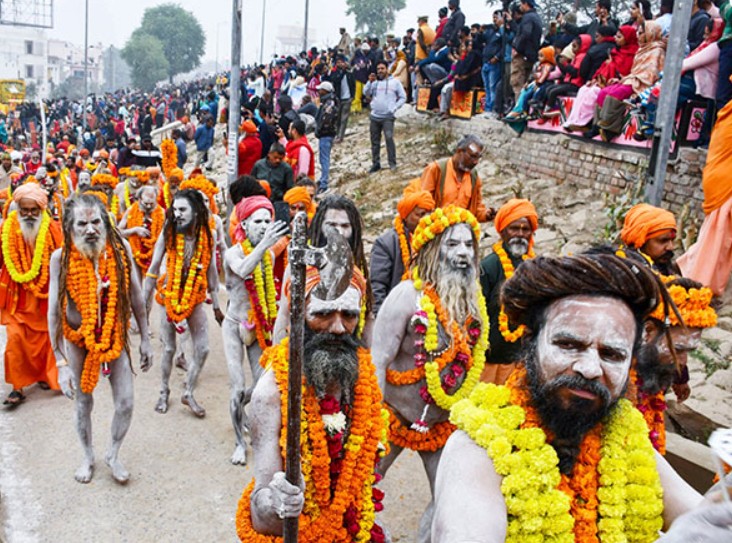Mahakumbh 2025 – 17 Adornments of Naga Sadhus- A Sacred Ritual of Devotion and Purity
17 Adornments of Naga Sadhus at Mahakumbh 2025- A Sacred Ritual of Devotion and Purity
The Mahakumbh, one of the largest and most significant religious gatherings in the world, is set to take place in Prayagraj, Uttar Pradesh, starting January 13, 2025. The event will continue until February 26, 2025, concluding on Mahashivratri. Known for its spiritual fervor, the Mahakumbh attracts millions of devotees and saints who come from all over the world to take a holy dip at the sacred Triveni Sangam, the confluence of the Ganges, Yamuna, and mythical Saraswati rivers.
Among the many saints participating in the Kumbh, the Naga Sadhus hold a special place. These ascetic monks, who have renounced worldly attachments in pursuit of divine enlightenment, are the focal point of the Mahakumbh. Their austere lifestyle, unique attire, and profound devotion make them a symbol of purity and spiritual power. One of the most intriguing aspects of Naga Sadhus is the 17 sacred adornments they wear before taking the royal bath in the holy river.
The Naga Sadhu: The Ascetic Monk
Naga Sadhus lead an austere life, free from material desires. The word “Naga” means “naked” in Sanskrit, reflecting their renunciation of worldly pleasures and attachments. They live in the wilderness, meditate for long hours, and dedicate themselves entirely to the worship of Lord Shiva. They wear minimal clothing, usually a simple cloth around their waist or none at all, symbolizing their detachment from materialism. Despite their renunciation of worldly possessions, Naga Sadhus observe a series of rituals and wear 17 adornments that hold deep spiritual significance.
These 17 sacred adornments are integral to their identity and devotion. Before taking the royal dip in the sacred waters during the Mahakumbh, they meticulously follow a series of rituals to adorn themselves with these items. Each adornment has symbolic meaning and serves as a reminder of their commitment to a life of asceticism and devotion to Lord Shiva.
The 17 Adornments of Naga Sadhus
- Ash (Vibhuti)
Ash, or vibhuti, is a key component of the Naga Sadhu’s ritual. It symbolizes purity, strength, and the annihilation of ego, representing the dissolution of worldly attachments. - Nappies
Nappies, worn as a simple cloth around their waist, signify the ascetic lifestyle of the Naga Sadhus. It is a modest piece of clothing, which highlights their renunciation of worldly pleasures. - Sandalwood
Sandalwood paste is applied to the body as a cooling agent. It is also considered auspicious and symbolizes peace, tranquility, and purity. - Silver or Iron Anklets
These anklets are worn to signify humility. They are also believed to protect the wearer from evil spirits and negative energies. - Panchakeshi (Top Twisted and Wrapped Five Times)
This is a unique hairstyle where the hair is twisted and wrapped five times, representing the five elements of nature – earth, water, fire, air, and ether. - Roli Paste
Roli, a sacred red powder, is applied as a mark of auspiciousness and blessings. It symbolizes the victory of good over evil. - Ring
Naga Sadhus wear rings as symbols of their bond with the divine. It represents their commitment to the spiritual path. - Flower Garland
A flower garland signifies purity and devotion. It is an offering to the divine, symbolizing the beauty and simplicity of the soul. - Tongs in Hands
The tongs carried by Naga Sadhus represent their control over the material world and their ability to transcend earthly desires. - Damru
The damru, a small drum associated with Lord Shiva, symbolizes the rhythm of the universe. It is believed to produce cosmic sounds that evoke spiritual awakening. - Kamandalu
The kamandalu, a water pot, symbolizes the importance of water in sustaining life and is a tool used during meditation and prayer rituals. - Dreadlocks
The tangled, matted hair of the Naga Sadhus symbolizes their renunciation of vanity and attachment to external appearances. - Tilak
The tilak, a sacred mark on the forehead, represents the third eye of Lord Shiva, symbolizing spiritual awakening and divine vision. - Lampblack
Lampblack is applied to the body to protect the skin and as a symbol of the Naga Sadhus’ determination to keep their devotion undisturbed by external influences. - Hard in Hands
The “hard” or stick that the Naga Sadhu carries represents authority and strength, both physical and spiritual. - Paste of Vibhuti
The paste of vibhuti is another application of sacred ash, used to purify the body and mind before embarking on a sacred ritual. - Rudraksh
Rudraksh beads are worn by Naga Sadhus to symbolize their connection with Lord Shiva. The beads are believed to have spiritual powers that aid in meditation and spiritual growth.
The Sacred Significance of the Adornments
These 17 adornments are more than just physical items. Each piece holds a deep spiritual significance, reminding the Naga Sadhus of their commitment to a life of asceticism and devotion. By adorning themselves with these items, they seek to align themselves with the divine forces of the universe, preparing for the royal bath at the Mahakumbh. It is believed that the royal dip in the sacred waters of the Triveni Sangam will cleanse them of past sins and bring them closer to liberation.
The Mahakumbh 2025 will witness millions of devotees gathering at Prayagraj to participate in this grand religious event. Among them, the Naga Sadhus stand as symbols of purity, devotion, and spiritual enlightenment. Their 17 adornments represent their deep connection with Lord Shiva and their commitment to living a life of detachment, austerity, and meditation. As the Naga Sadhus prepare for their royal bath, their rituals serve as a reminder of the profound spiritual journey they have undertaken, one that transcends the material world and reaches toward the divine.
Also Read-
